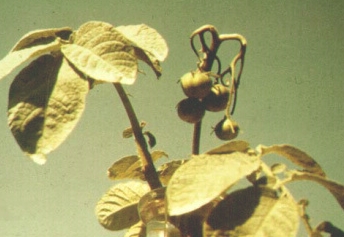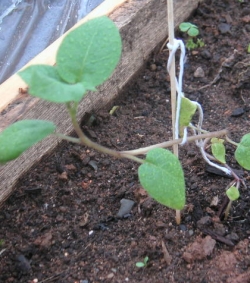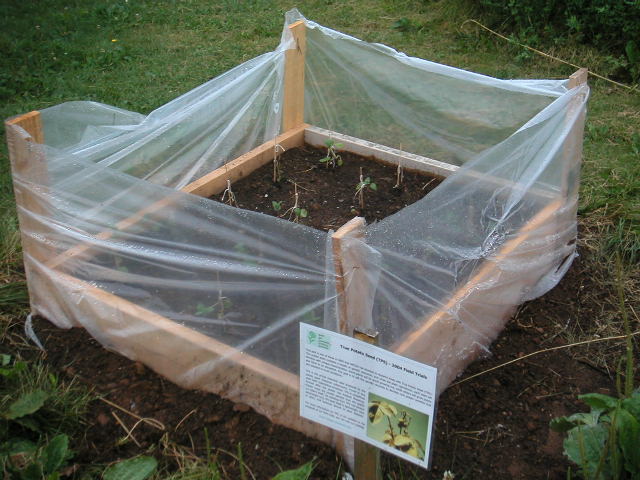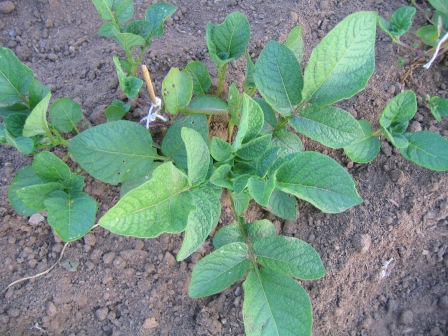True Potato Seed (TPS) - 2004 Field
Trials
What is TPS?
| True Potato Seed (TPS)
is the actual botanical seed produced by the potato plant (Solanum
tuberosum). Found in tiny seed balls resembling tomatoes, TPS is
occasionally formed after the potato has finished flowering (Figure
1). Potato crops are usually planted from the potato (or tuber)
itself, but planting from TPS has several advantages.
Firstly, while TPS can be challenging to obtain,
it is far less likely to harbour disease. In fact, only one disease
(Spindle Tuber Virus) has been found in TPS, while tubers can host
bacterial wilt, late blight, and many other diseases affecting the
commercial potato industry. More importantly, the peculiarities of
potato genetics cause plants grown from TPS to be markedly different
from the parent plant and from each other. This diversity helps ward
off incidences of plant disease while offering gardeners an
opportunity to develop their own varieties. |

|
| Figure 1. TPS forms
immediately after flowering. |
How is TPS developed?
|

|
The potato plant contains a wealth of genetic
resources. While containing only 12 chromosomes, potato varieties can
have multiple copies of these chromosomes. Cultivated varieties, for
example, have four copies, for a total of 48 chromosomes.
When the potato plant reproduces, usually though
self-pollination, the chromosomes (along with the genes they carry) are
reshuffled, distributing themselves randomly to the seeds. Each seed
will develop into a plant with unique characteristics. Some will have
red tubers, others will demonstrate excellent disease resistance. Some
will be worth growing out for generations, while others will grow poorly
and have to be discarded.
TPS is collected and saved in a manner similar to
that used to save tomato seeds. When the seed balls are green and soft
to the touch, they are removed and cut in half. The seeds are then
squeezed out into a shallow container, covered with water, and allowed
to ferment for three days. They are then removed, washed using a sieve,
and allowed to air dry.
TPS is usually stored in a cool, dry place for
about eight months before planting them indoors into trays and
transplanted out to the field (Figure 2). Before planting out, the seeds are
usually treated with plant growth hormone. This, along with the
fermentation process, helps to ensure proper germination.
|
| Figure
2. TPS transplant. |
NECGA Research Trials
Beginning in June 2004, we will plant out
approximately 300 true potato seeds obtained from Dan O'Brien, one of our Home
Garden Project participants, in an effort to develop new potato varieties
adapted to urban growing conditions. We will be selecting for disease
resistance, tuber size and flavour, and days to maturity. Highlights are
outlined further below:
|
Update for August 7,
2004
- The Group 1 seedlings have been
transplanted into a test plot at the Gorsebrook Community Garden.
- 2 of these died within two days of
transplanting.
- Of the 15 Group 2 seedlings, 5 have
failed since the last update.
Update for September 1,
2004
- 11 Group 1 seedlings are
flourishing at the Gorsebrook Community Garden. 4 died since
transplanting in late-July.
- As the gardening season is drawing to
a close, it was decided that the Group 2 seedlings should be
abandoned.
- The 2004 trials will now focus on the
remaining 11 seedlings, which have established themselves well.
|

|
|
 |
Update for October 11,
2004
-
To extend the growing
season, a cold frame is now covering the test plot.
-
A cold snap, followed by
a warm period, has caused many of the potato plants to develop
blight-like symptoms on the foliage.
-
Many of the plants have
developed potatoes, however, and all will be harvested at the end of
the month.
Update for October 22,
2004
- All potatoes have been harvested. As
expected, tubers differ widely between plants.
- Measurements for a number of physical
characteristics were noted, including foliage cover, leaf size,
number of tubers, etc.
- As the tubers may not hold up under winter
storage, the tubers will now be planted indoors under grow lights
and allowed to form new plants asexually.
- The next generation of tubers will then be
planted into the field in the spring.
|
TPS Links
http://www.cipotato.org/projects/PF03_truepotatoseed.htm
The CIP (Centro Internacional de la
Papa) or in English, the International Potato Institute, is an excellent
resource for information on the potato crop. This site outlines current research
on TPS and its potential for use in the Third World.
http://www.worldandi.com/public/1987/june/ns3.cfm
This website gives a quick overview
of potato biology and how TPS is developed.
A Brief History,
Farming... in the city?,
NECGA Forum,
Where we are, How we work,
Programs/Services,
Home Garden Project,
Who
We Are,
Publications
and Forms
Home
© 2004 North
End Community Gardening Association

